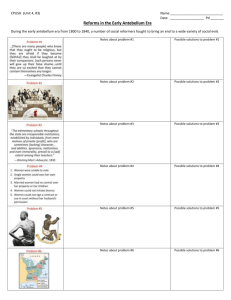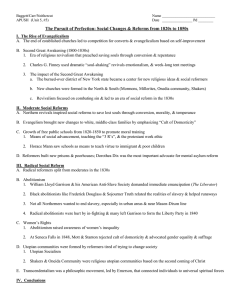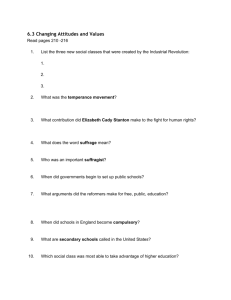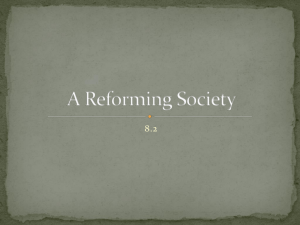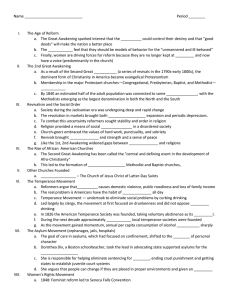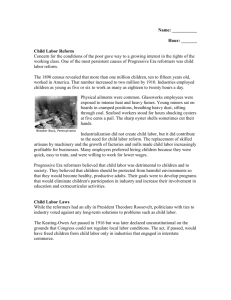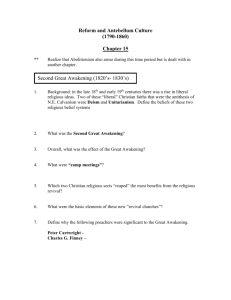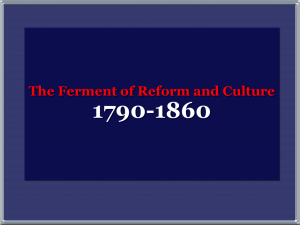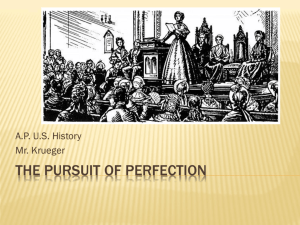CHAPTER 8 A PUSH FOR REFORM
advertisement
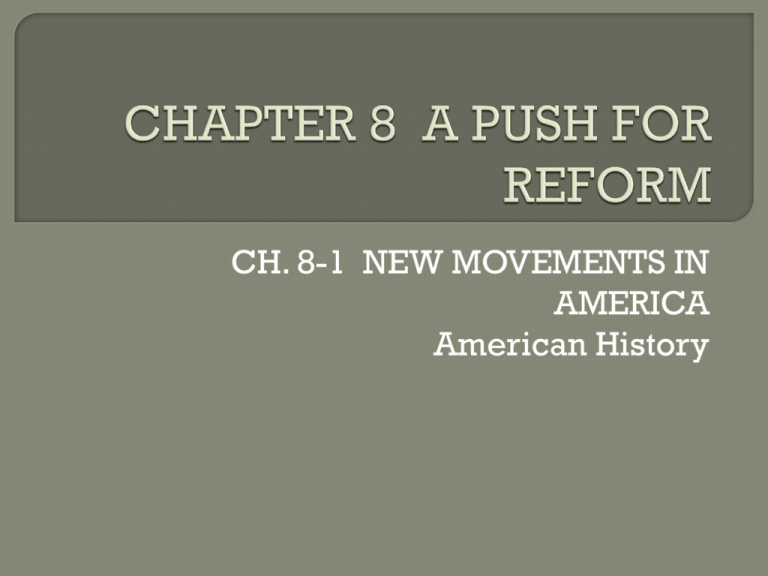
CH. 8-1 NEW MOVEMENTS IN AMERICA American History Most famous preacher—Charles Grandison Finney Led revivals designed to awaken religious feelings THE SECOND GREAT AWAKENING 1820-1850—number of people attending church doubled Movement called “Second Great Awakening” “First Great Awakening” occurred in 1700s Many preachers were Protestant They DID NOT teach strict adherence to church rules, or obedience to a minister. Preachers said that destiny lay in their own hands People were told to live well and work hard. Second Great Awakening helped launch a remarkable period in American History “The Reform Era”—1830-1860 Americans attempt to reshape American Society THE TEMPERANCE MOVEMENT One of the main goals of reformers was to reduce the use of alcoholic beverages TEMPERANCE—moderation Books, plays, songs written about evils of alcohol. Reformers also started temperance societies. 1851—Maine outlaws alcohol 12 states follow in the next several years. Prior to 1840s—American schools were either private schools or common schools Common Schools—free public schools where children learned basic reading, writing, and math skills Most families couldn’t afford private schools Quality of teaching in common schools was generally poor. THE COMMON-SCHOOL MOVEMENT Reformers wanted children to be educated Educated people made better decisions and that wide-spread education was fundamental to a democratic society Education reformers organized themselves into “friends of education” HORACE MANN The greatest education reformer of the era Mann advocated a new, highly organized approach to education He said states should fund education and schools should be controlled locally Compulsory attendance Creation of so-called normal schools where teachers would be trained 1839—MA creates the first normal school 1852—MA passes first compulsory attendance law in the USA Other states copied Mann’s work 1860– 6 out of 10 white children attended school (double from 30 years before) Reformers didn’t or couldn’t help Native Americans or African Americans WILLIAM MCGUFFY Another well-known reformer Wrote and published a series of textbooks called “Eclectic Readers” Became known as “McGuffy Readers” Books written for different grade levels Taught reading and moral and intellectual values Over 100,000,000 were sold Nearly every American student used them in the middle and late 1800s DORTHEA DIX—campaigned for humane treatment of prisoners Taught Sunday school to prisoners 1841 Mentally ill and non-violent criminals were confined with violent criminals Horrible overcrowding Unsanitary conditions Prisoners were abused by jailers MA created state-supported institutions to treat and house mentally ill people, separate from criminals Dix and supporters convinced other state governments to create similar institutions TRANSCENDENTALISM UTOPIANISM AND TRANSCENDENTALISM—the belief that knowledge is found not only by observation of the world but also through reason Thus, by transcending, or going beyond, observation, people can have a deeper and truer understanding of the world RALPH WALDO EMERSON The leading transcendentalist Gave sermons and lectures and wrote essays Self-reliant and trust their intuition Transcendentalists supported reform America’s most renowned authors HENRY DAVID THOREAU Firmly believed in the power of selfreliance and individual thought 1845—Thoreau lived in a small cabin by Walden Pond, MA He thought simple living would lead to meaningful life People should act according to their own beliefs, even if they had to break the law 1846-Thoreau refused to pay a tax he thought would promote slavery He spent a night in jail In the essay “Civil Disobedience” he said “that government is best which governs least” “Civil Disobedience” was very influential Mohandas Gandhi, Martin Luther King, Jr. UTOPIANISM Some reformers wanted to create new communities that were free from social ills UPTOPIA— ”the perfect society” One community was led by Robert Owen 1825—He purchased the town of Harmonie, IN Owen attempted to start a utopian community in Harmonie, IN Residents failed to implement Owen’s ideals and the community failed 3 years later Another community occurred in 1841 at Brook Farm, MA. It failed due to mounting debt in 1847 Most communities were small and shortlived. A notable exception were communities built by the Shakers Shakers—Christian sect Started building communities in the late 1700s By the 1830s, nearly 6,000 Shakers lived in more than a dozen communities throughout the USA. THE END
